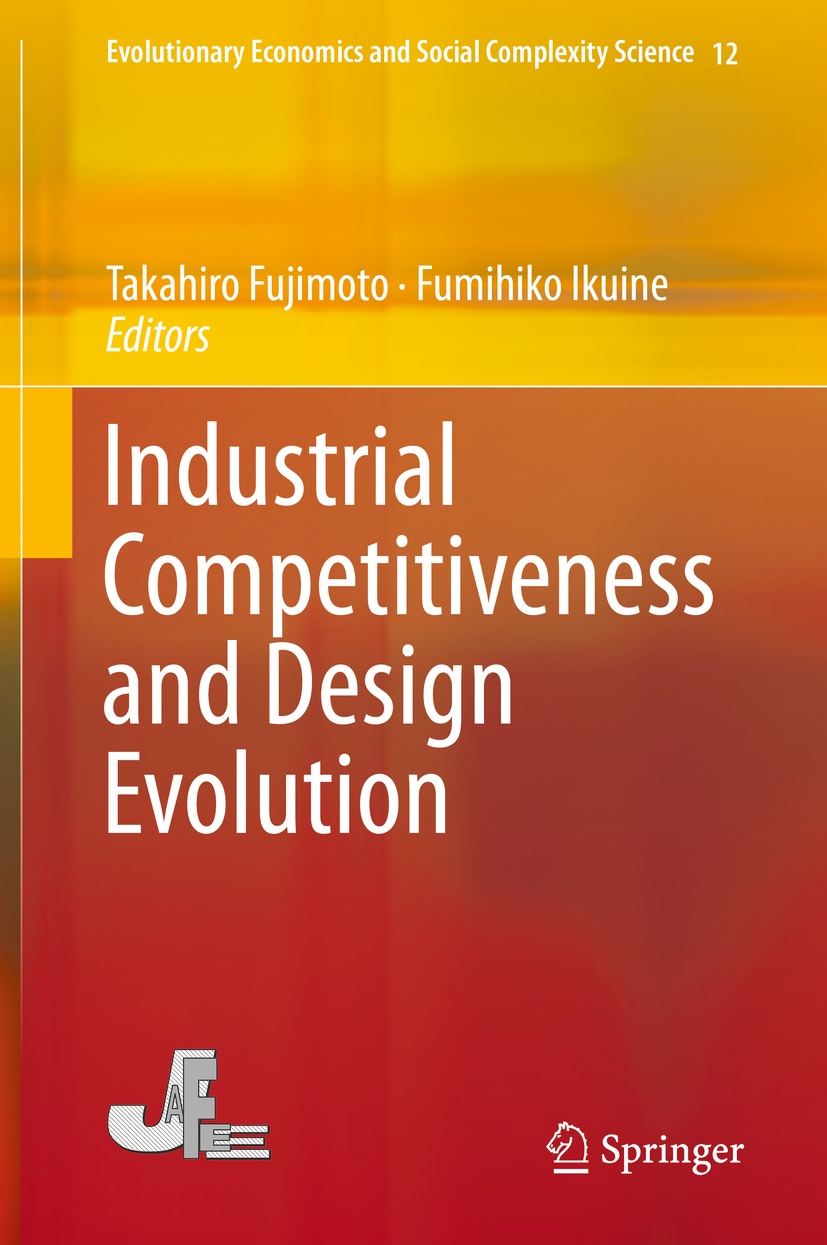
Title
Evolutionary Economics and Social Complexity Science 12 Industrial Competitiveness and Design Evolution
Size
425 pages, hardcover
Language
English
Released
2018
ISBN
978-4-431-55144-7
Published by
Springer
Book Info
See Book Availability at Library
Japanese Page
The purpose of this edited book is to explore the evolution of industries and firms both theoretically and empirically. Theoretically, we will combine the theory of manufacturing capability, the concept of product-process architecture, and classical (Ricardian and neo-Ricardian) trade theories, integrating them into an evolutionary economics framework. As the common element of industries and firms is the so-called manufacturing site (genba), that is, the place where value-added flows, we adopt the manufacturing site as the basic unit of our analysis.
This book adopts the following theoretical topics: evolutionary perspectives of capability architecture fit for industrial comparative advantage, design-based view of manufacturing, evolution of manufacturing capabilities, Ricardian comparative advantage with changing labor and material input coefficients, comparative design costs and selection of design locations, evolution of architectures within a product category, resource-based view of the firm and its growth, evolution of product architectures across industries (particularly in the open architecture environment), cumulative demand creation by means of network externality among complementary goods in digital industries with open architecture platforms, evolution of product designs in the industrial lifecycle, evolution or expansion of product variety for effective demand creation, international division of labor that matches the distribution of knowledge, and simultaneous pursuit by firms of productivity increase and effective demand creation (or stable employment and markup ratio) at all levels, that is, at the site-firm-industry-economy level.
Part I deals with the theoretical framework and models. Special attention is paid to their applicability to the main industrial trends of the late twentieth century and early twenty-first century, such as global competition between advanced and emerging countries and the global digitalization of industries. We propose a capability-architecture-performance (CAP) framework, which is derived from our broad concept of manufacturing, for managing flows of value-carrying design information to customers.
In this framework, Japan is endowed with coordination-rich manufacturing sites that tend to have design-based comparative advantages for coordination-intensive products, including automobiles. When digital technological innovations triggered rapid growth in products and platforms with coordination-saving open-modular architectures and open interfaces, many leading Japanese firms in the electronics industry found it difficult to formulate appropriate strategies vis-à-vis American platform-leading firms (e.g., Intel, Microsoft, Apple, Google, and Amazon) and factories in low-wage emerging countries, such as China. The book explains the evolutionary dynamics of industrial competitiveness, architectural changes, and capability building.
In Part II of the present book, we shed light on the first aspect of the CAP approach, or the capability building of manufacturing firms and sites in response to increasingly intense global competition in recent years. We argue here that efforts for manufacturing capability building to ensure better flows of value-carrying design information to customers in the market occur at multiple levels of industries, firms, and sites when global competition is intense.
In part III, we discuss the second main aspect of the CAP framework, or architectural evolution and demand creation in digital industries, many of which are characterized both by open-modular architectures with industry-standard interfaces linking mutually complementary products and components and by competition among rival platforms.
Thus, the book proposes an evolutionary economic framework that includes capability, architecture, and performance as its main components.
(Written by FUJIMOTO Takahiro, Professor Emeritus, Graduate School of Economics / 2024)
Table of Contents
A Design-Information-Flow View of Industries, Firms, and Sites
Takahiro Fujimoto
The Nature of International Competition Among Firms
Yoshinori Shiozawa and Takahiro Fujimoto
Product Variety for Effective Demand Creation
Yoshinori Shiozawa
Capability Building and Demand Creation in “Genba-Oriented Firms”
Takahiro Fujimoto
Evolution of Business Ecosystems
Hirofumi Tatsumoto
Part II Multi-layer Capability Building in Response to Global Competition
Evolution of Organizational Capabilities in Manufacturing: The Case of the Toyota Motor Corporation
Takahiro Fujimoto
The Nature of Surviving Japanese Factories in the Global Competition: An Empirical Analysis of Electrical and Electronics Factories
Mitsuhiro Fukuzawa, Nobuyuki Inamizu, Junjiro Shintaku, Kodo Yokozawa, and Nobutaka Suzuki
The Effectiveness of Group Leaders in the Lean Production System: Time Study and Agent-Based Model of Leaders’ Behavior
Nobuyuki Inamizu and Mitsuhiro Fukuzawa
The Diversity and Reality of Kaizen in Toyota
Shumpei Iwao
Balancing Standardization and Integration in ICT Systems: An Architectural Perspective
Young Won Park and Takahiro Fujimoto
Part III Architectural Evolution and Demand Creation in the Digital Industries
Creating New Demand: The Competition, Formation of Submarkets, and Platforms
Fumihiko Ikuine
Decline in Demand Creation: The Development Productivity Dilemma and Its Consequences
Fumihiko Ikuine
Investigating the Creation and Diffusion of Knowledge for Demand Creation: The Case of the Telecommunications Industry
Wei Huang, Masanori Yasumoto, and Jing-Ming Shiu
The Impact of Platform Providers’ Knowledge on Interfirm Division of Labor: The Case of the Mobile Phone Industry
Jing-Ming Shiu and Masanori Yasumoto
Conclusion
Takahiro Fujimoto and Fumihiko Ikuine



 Find a book
Find a book


 eBook
eBook



